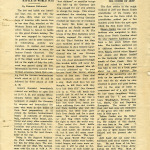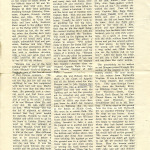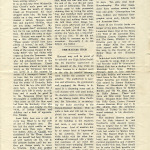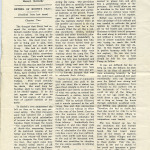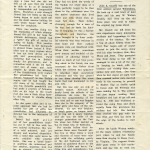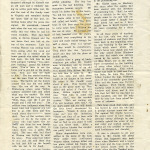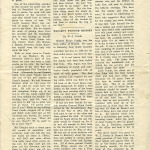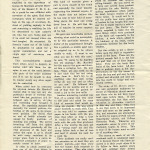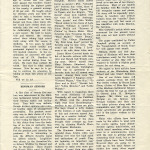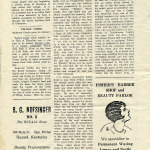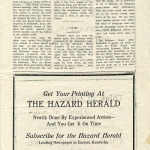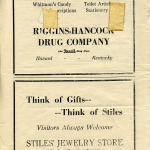Pine Mountain Settlement School
Series 27: Scrapbooks, Albums, Gathered Notes
LOCAL HISTORY SCRAPBOOK The Mountain Magazine
Vol. 1 No. 2 October, n.d. (c. 1918)
TAGS: LOCAL HISTORY SCRAPBOOK The Mountain Magazine; World War I; Demmer Richmond; Mason Combs; Enoch ‘Chunk’ Craft; Hazard High School; student literary and musical tastes; Civil War; John A. Caudill; Prof. Clarke; Miss Stone; General Elijah Combs; Oliver Hazard Perry; W.J. Combs; Jesse Combs; Dr.Taylor Hurst; Hindman High School; Anderson Combs; Jerry Combs; Tunnel Mill; Yellow Creek; coal companies; teachers; Native Americans; African-Americans; pioneers; George M. Marshall; telegraph service; President Hoover; advertisements
CONTENTS: Local History Scrapbook The Mountain Magazine
Sudie Knight, Editor & Publisher, Office in the Hazard Herald Building, Hazard, Kentucky.
[*Articles in the following list that have asterisks are transcribed below.]
Page 1 (030): “The First American Battle in World War” by Demmer Richmond, Whitesburg, Kentucky, member of the Rainbow Division in WWI.
Page 1 (030): “Sketch by Rev. Ira Combs of Jeff”*
Pages 2-3 (030a-b): “Morgan’s Men – Reminiscences of Enoch ‘Chunk’ Craft,” of Millstone, Kentucky, one of the few survivors of a Confederate company in the Civil War.
Page 3 (030b): “The Hazard High”*
Pages 4-5 (030c-d): “Bethel of Boone’s Track (Trace?)” (Chapter Two: Continued from last issue. To be continued) A young girl endures capture by “Indians.”
Pages 5-6 (030d-e): “Civil War Times in and Around Whitesburg” by Watson Caudill, Sr.*
Pages 6-7 (030e-f): “Prof. Clarke Remembers”*
Page 7 (030f): “Hazard’s Pioneer History” by W.J. Combs*
Page 8 (030g): “What Physical Training Can Do For Us” by G.H. Marshall, who describes George M. Marshall, then secretary of the Hazard YMCA.
Pages 8-9 (030g-h): “How Dr. Hurst Climbed the Ladder”*
Page 9 (030h): “Hindman Seniors”*
Pages 9-10 (030h-j): “Articles to Appear in Our Next Issue”
Pages 10-11 (030j-k): “Yellow Creek” Anderson Combs Gives Its History.* Two advertisements: B.G. Nofsinger No. 2 “The Rexall Store” and J.C. Fisher’s Barber Shop and Beauty Parlor, both in Hazard, KY.
Page 11 (030k): “Luck”: Advice to teachers: plan ahead, stick to it, and luck does all the rest.
Page 11 (030k): “The Telegraph and the White House”: President Hoover’s modern methods of communications.
Page 12 (030l): Two advertisements: Riggins-Hancock Drug Company (The Rexall Drug Store) and Stiles’ Jewelry Store, both in Hazard, KY.
GALLERY: Local History Scrapbook The Mountain Magazine
- Mountain Magazine (Hazard Herald), page 30. [local_hist_album_030.jpg]
- Mountain Magazine (Hazard Herald), page 30a. [local_hist_album_030a.jpg]
- Mountain Magazine (Hazard Herald), p. 30b. [local_hist_album_030b.jpg]
- Mountain Magazine (Hazard Herald), page 30c. [local_hist_album_030c.jpg]
- Mountain Magazine (Hazard Herald), page 30d. [local_hist_album_030d.jpg]
- Mountain Magazine (Hazard Herald), page 30e. [local_hist_album_030e.jpg]
- Mountain Magazine (Hazard Herald), page 30f. [local_hist_album_030f.jpg]
- Mountain Magazine (Hazard Herald), page 30g. [local_hist_album_030g.jpg]
- Mountain Magazine (Hazard Herald), page 30h. [local_hist_album_030h.jpg]
- Mountain Magazine (Hazard Herald), page 30j. [local_hist_album_030j.jpg]
- Mountain Magazine (Hazard Herald), page 30k. [local_hist_album_030k.jpg]
- Mountain Magazine (Hazard Herald), page 30l. [local_hist_album_030l.jpg]
TRANSCRIPTIONS OF SELECTED ARTICLES: Local History Scrapbook The Mountain Magazine
[The following text has been slightly edited.]
“Sketch by Rev. Ira Combs of Jeff”
[local_hist_album_030.jpg] Page 1, Column 3
SKETCH BY REV. IRA COMBS OF JEFF
The first settler in the neighborhood of Jeff was Mason Combs, grandfather of Ira Combs, who now lives on the farm which his grandfather settled just a few hundred yards from the spot upon which the first house stood.
Mason Combs was one of seven brothers who emigrated to Kentucky from North Carolina about the year eighteen hundred or perhaps a few years before that date. The brothers scattered out in different directions. One of them, Elijah, settled where Hazard now stands and Mason located on the Kentucky River near the mouth of Carr Creek. Here he lived and raised his family and was laid to rest on a little point above the new highway.
The shriek of the locomotive and the honk on the speeding automobile now rend the air which he once breathed in peace and quiet, broken only by the song of birds or occasional call of a wild turkey. He had three daughters, Nancy, Willie and Tach and several boys, Washington, Preston, Talton, Marin, Clin and Napoleon Bonaparte. The names of the first and last ones are reminders of the great men who made history in that epoch. Talton Combs was the father of eight sons among whom was Ira, the subject of this sketch, who was born in the year ? He remembers when there were only two or three houses between Hazard and the present site of Jeff.
Jeff itself did not come into existence until [1902] about sixteen years ago. He and three of his brothers served in the Union Army during the Civil War. Most of their time was spent near Lexington and Winchester. Their commanding officer was Col. H. C. Lilly who afterwards became the first judge of Knott County. Next in rank was Lieut. Col. Heard. Other officers were Eversole, Fields, and Stacy.
“The Hazard High”
[local_hist_album_030b.jpg] Page 3, Column 1
THE HAZARD HIGH
Hazard may well be proud of its splendid new High School building. Its imposing appearance at the summit of the long slope up Baker Avenue is a decided asset to the city its interior arrangement fulfills the promise of its exterior. The auditorium is spacious and attractive, the gymnasium well equipped, the library is located in a charming room and is well stocked with well-used books; the students seem to have developed the library habit.
Miss Faulkner, the Librarian, is re-cataloging the books according to the Dewey-Decimal System. This is quite a task and will not be completed for several months. One of the many admirable features of the building is the teacher’s restroom, a cozy and homelike little room. Last of mention but by no means least in importance is the cafeteria. The array of white tables with the other furnishings all arranged with a nicely and exactness of eye make the food even more tempting. However, no additional stimulus of this kind is needed. The cooks are up to the same high standard of efficiency which is maintained in every department.
The writer had the pleasure of a fifteen-minute interview with the Junior year students in their English Class under Mrs. Ross.
[local_hist_album_030b.jpg] Page 3, Column 2
Although the time was short, quite a few interesting things came to light which indicate the general trend of literary and musical taste among the students. The most widely [read] magazine proved to be Popular Science which is read by 15 boys. Ten girls read Good-Housekeeping. The other magazines have readers among both boys and girls. Cosmopolitan has nine, Colliers and National Geographic seven each, Liberty five and American four.
Some of the favorite books are The Keeper of the Keys, Beau Sabreur, Lonesome Road, End of the Road, (17) Trail of the Lonesome Pine, Robinson Crusoe, Captain Blood, and The Snare. Whittier is their favorite poet by a vote of 21, with Edgar Allen Poe running close second with 20. Poe, by the way, is the favorite of the Senior Class of the Hindman High.
Individual tastes differed so much in regards to songs that no general favorite could be determined. Robert Cole has a feeling for the “Mountain Love Song.” William Strong‘s taste is less romantic but quite healthy and normal; his heart turns to “The Old Gray Mare.” Other favorites are “Indian Love Call,” named by Lorena Robinson, “Waters of Minnetonka” by Viola Bower, “Carolina Moon” by Robert Raider, and “Till We Meet Again” by Callie Patton. The well-known old-time songs found partisans. Douglas Horn likes “Darling Nelly Gray,” Lucien Norman chooses “Swannee River” and C. B. Dix admits that the melodious strains of “Turkey in the Straw” sound sweetest to his discriminating ear.
The students deserve approbation for their interest in and familiarity with classical music. This is largely due to the radio program broadcasted from New York last winter by Walter Damrosch. The Hazard High is fortunate in being able to give the boys and girls this course in musical appreciation and evidently they realize this fact. They should try to make the best possible use of their opportunity and appearances indicate that they are doing so.
A good descriptive article concerning the schools of Hazard appeared in the January issue of the L & N. Employees’ Magazine. It was written by F. D. Baker.
“Civil War Times in and Around Whitesburg”
[local_hist_album_030d.jpg] Page 5, Column 3
CIVIL WAR TIMES IN AND AROUND WHITESBURG
By Watson Caudill, Sr.
John A. Caudill was one of the first settlers around Whitesburg. He took up a vast tract of land there and his son, W. Watson Caudill, still lives on the old home place very near to where the original log house stood.
Mr. Caudill can tell from his own experiences many interesting incidents and happenings in this section of the country. He was a boy of about fifteen when the Civil War began and of course wanted to join the army, along with his older brothers, Sam, Ben, Dixon and Jesse. They prevented him from doing so but still, he managed to see a lot of the war by keeping in touch with his brothers and visiting their companies now and then.
One time when he had stayed all night with Sam, command orders were received early in the morning to proceed to Hyders Gap at double quick to [forestall] the Federals who were making for it. The soldiers had just begun cooking their breakfast and had to go off and leave it. The boy wandered around the campfires and dined royally from the provisions the soldiers had left. His brother Sam reached the gap with his men first and they lay down in the edge of the bushes to wait attack.
After the battle Watson watched the Negro soldiers retreating past where he and his family were then staying in Russe[ll] County, Virginia. The Negroes threw their guns away in this excitement and, boy, like he went out into the road and picked one up. Just as he was carrying it to the house the Confederate soldiers began passing. One hailed him and told him to take the gun back where he got it for if he was seen with an enemy’s gun by soldiers who did not know…
[local_hist_album_030e.jpg] Page 6, Column 1
…him it might cause him trouble.
His father, John A. Caudill, because of having four sons in the Confederate Army, was naturally in disfavor with those of his neighbors who were Unionists and several times his life was endangered, although he himself was an old man and a minister taking no active part in the war. He and the rest of the family went to Virginia and remained during the latter half of the war, returning home after the peace was signed.
He considered himself safe after the war was ended but really this was when he had his worst troubles. They had their cattle in Morris Branch and the one horse that was left at the top of the mountain. Late one evening, Watson was coming home from seeing after the stock and was met by a member of the home guards who asked where he had been. He told him he had been pawpaw hunting. “Yes, pawpaw hunting,” [jeered] his interrogator. “You’ve been to see the horse you’ve got hid on the mountain. Now you lead me right to him.” The boy started running and the man fired at him three times. The bullets cut the bushes around him but did not strike him.
He ran all the way to Whitesburg where some Yankee soldiers accosted him and asked what was the matter. He tried to put them off but they insisted. “Well, then, wait till I get my breath and I will tell you.” The soldiers were indignant when they heard what had happened and told him to go with them and they would shoot the…horse thief. Two of the soldiers were cousins of his by the name of Brown who had taken the opposite side from his own family. They went down the river to where there was a [party] that night. The man who had fired at Watson was trying to court his niece. They asked her where he was and she told them that he had just left up the branch with his hat in his hand.
This same man and his brother once came to Mr. Caudill’s house at night to kill him. Watson was upstairs over his father’s room in bed when they came. An old Negro couple were downstairs. They came in and told Mr. Caudill to get up and come with them…
[local_hist_album_030e.jpg] Page 6, Column 2
…for he was going to die. He made answer that he was prepared to die at home. This reply was a little unsettling to them for they did not understand what he meant by being prepared to die. The old Negroes put up most pitiful pleading. The boy lay quiet in the bed listening. The marauders became urgent. He heard his father say to the Negro, “Go tell the boys to come down.” The Negro came to the stairway and called out loudly, “Hey dere, boys de Old Boss says for youse to come down here.” Watson took the cue at once. He jumped out of bed, knocked over the chairs, stumbled over everything in the room and made racket enough for half a dozen. That was enough for they would be executioners. They didn’t like the “preparations” and they left the place at double quick.
Another time a gang of bushwhackers got after Mr. Caudill near Whitesburg and he reached refuge at the home of an old man named Billy Hilton. Mr. Hilton told him to come in. He had two sons and said there would be no danger in his house. He asked if Mr. Caudill could shoot a gun. They barred the door as the posse came up. They called and asked if Caudill was there. Hilton replied that he was. “Tell him to come out here.” “No,” was the resolute answer. “He’s not coming out. I’ve got business with him.” “If he don’t come out we will break the door down,” threatened the besiegers. “Break it down and come on,” was the invitation. “There are four of us here with our guns sighted on the door. Just as fast as you enter it we’ll lay you there dead. After a little further bluster, the murderous party went away.
Minor depredations were committed in the name of the Law. Their cattle were confiscated, wagons taken, turkeys killed and bee gums robbed but finally the inflamed spirit subsided, old grudges were gradually forgotten, and with the passing years, friends and foes were gathered together for their last sleep in the quiet hillside graveyards. Peace [?]ed over the calm mountain ranges and only memory recalls the troubled days of old.
“Prof. Clarke Remembers”
[local_hist_album_030e.jpg] Page 6, Column 3
PROF. CLARKE REMEMBERS
Ever since I have been in the mountains I have heard of Prof. Clarke of Hindman. Miss Stone says he did the first real pioneer work for education in Knott County but, of course, she did her part in the pioneering too.
Mr. Clarke came to Hindman two years after the county had been created with the intention of practicing law. “But,” he said with a twinkle in his eye, “the people came to me and told me they would rather I taught ’em than lawed ’em and so I have taught here in Knott County for 32 years excepting for a short time.”
In all these years of teaching, he has lost only two days on account of sickness and these two were back in the beginning when he was teaching in the new log house which stood where Dr. Kelly‘s house now stands and was the only schoolhouse Hindman has ever had which was entirely owned by the county. Either he or Miss Stone, one or the other, have cooperated in the building of every other school house located at Hindman. This schoolhouse was built in 1888 and Peyton Duke, Dr. John Wes Duke‘s father, hauled the logs. Different ones of the community gave their labor and the house was finished by degrees. Prof. Clarke began teaching while it was still minus windows and doors and it was late that fall that he was laid up with tonsilitis and lost the only time he ever lost from school because of sickness.
This house stood four years and was burned by someone who had a grudge against someone else. Not against Mr. Clarke however. He seems never to have made a personal enemy although he consistently upheld the cause of law and order and worked openly against all who assisted or encouraged lawlessness and disorder.
It was a pleasure to sit and listen to Mr. Clarke tell about things that happened way back there when Hindman was a brand new town and the hogs rooted the old schoolhouse over in the creek, when the “bonded warehouse” stood staunch in the forks of Troublesome and when the old feuds flared up fiercely just as the embers were on the point of burning out; when he kept his school boys on guard around his house at night with guns on…
[local_hist_album_030f.jpg] Page 7, Column 1
...their shoulders, when he watched an attack on the jail from his own doorway, and when the peaceable citizens of the town joined themselves together in a vigilante committee with the determination to stamp out lawlessness and [make?] a safe nesting place for the dove of peace.
One of the interesting episodes in this crusade for peace was the trip to Frankfort to get guns and to secure the goodwill and cooperation of the Governor in case they should have to enforce peace by means of war. “It wasn’t because there was any lack of guns,” he said. “Nor of men to use them. But we wanted the name of getting them from the Governor and the knowledge that he was backing us. Sheriff J. D. Watts, Pearl Combs who was County Clerk, Jim Hudson a Baptist preacher, Judge Baker, and myself were the ones who made the trip.”
Well, we went down to Frankfort to see Buckner. He was Governor then—a kind of low, heavy-set man and wore a little goatee on his chin. He had been a general in the Civil War and had surrendered Fort Donelson to Grant. Afterwards, he and General Grant were great friends and he was one of the pallbearers at Grant’s funeral.
We told Governor Buckner what we had come for and he said we could have the guns. He told us to go back and straighten things out if we had to kill the whole outfit that had been making the trouble. “I’m backing you,” said he, “and if you have to kill ’em to quiet ’em, just go ahead. I’ll pardon every one of you.” While he was talking, Pearl Combs dropped off to sleep and didn’t wake until just as the Governor was leaving. He jumped up, rubbing his eyes. “What did he say, boys? Is he goin’ to let us have ’em?”
We brought back a dozen guns, 500 rounds of ammunition, and somebody went and told the outlaw bunch all about it. “Boys,” he told Dolf and some others, “You better mind what you’re doing now for they sure got the guns and the Governor said for them to kill every one of you fellers and he would pardon them for it.” Well, that friendly warning did more good than anything else could have done. We never did have any real trouble, though the guns were used more or less at different times. We kept them…
[local_hist_album_030f.jpg] Page 7, Column 2
…several years and one of them was burned in the Bailey Hotel. Finally, I happened to remember that my name had been used in getting them so I gathered up the eleven that were left and took them back to Frankfort. Bradley was Governor then and I asked him what about the gun that had been burned. He said, “Oh, that will be all right.” And so the matter ended. But the funniest thing about the whole affair is how Pearl Combs went to sleep while the Governor was talking after all the trouble he had been in making the trip to see him.”
“Hazard’s Pioneer History” by W.J. Combs
[local_hist_album_030f.jpg] Page 7, Column 2
HAZARD’S PIONEER HISTORY
By W. J. Combs
General Elijah Combs was the first settler of Hazard. He came to Kentucky from North Carolina sometime previous to 1798, for his first child, Jesse, was born in that year. It is not known how long the family had been here before that time. This region was then a wilderness of forest and canebrakes thickly populated with all sorts of wild game. The first day General Lije occupied his new log cabin, which was built on the hill back of the Court House near Little Boulevard, he killed a wild turkey on the corner of the house and the next morning shot a deer from his doorway. There were buffalo roaming around in these mountains, too, at that time.
It has not been decided for certain whether General Elijah Combs served in the Revolutionary War or in the War of 1812. But he took part in one or the other and there gained his rank. If records could be found giving his age this point would be cleared up for if he was old enough to have been in the Revolution he would have been too old for the War of 1812. He was one of seven brothers who came to Kentucky about the same time and settled in various places between Carr Creek and Lexington. All of these pioneer Combs’ were Whigs except one of the seven brothers who was a Tory and was called “Old Danger.” The Democratic Combs’ appear to have descended from “Old Danger.”
Perry County was originally a part of Fayette, later it was included in Clay. It was a part of Clay County in 1810 when…
[local_hist_album_030f.jpg] Page 7, Column 3
…General Lige made his first land survey and this old survey is now on the record book in Manchester. Perry County was created in 1820 and both it and its county seat were named for Oliver Hazard Perry, the famous young commander who met the British on Lake Erie and sent to Congress the historic message, “We have met the enemy and they are ours.” It would be interesting to know who suggested these names for the county and town.
Perhaps it was Gen. Lige himself for he was a soldier and would naturally have been fired with enthusiasm over this great victory and would have had the desire to immortalize [the] hero. He probably served as first jailer for he made a trip to Irvine to have a lock made for the jail. It was a great cumbrous lock weighing 50 pounds and the key was a fit match in size, almost half as long as a man’s arm. W. J. Combs says he remembers the key well. The Jailer then received the munificent sum of $12.50 for his services and the County Judge the same.
Jesse Combs, the oldest son of Gen. Lige was the first county clerk and held that office continuously for 53 years. Part of this time he served as circuit clerk also. This is a unique record and one of which his descendants should be proud. It proves him to have been a man who stood high in the estimation of all who knew him. It is likely that he was personally acquainted with most all of the voters, for in those days the voting was all done at Hazard and two or three days was given over to it. An election must have been a picturesque and vastly interesting event. After the death of Jesse Combs in 1874 his grandson, Ira J. Davidson, succeeded to the office and held it for 18 years.
(The above sketch was given by W. J. Combs of Hazard who is a great-grandson of Gen. Lige. Another article will appear later after he has looked over some of his family records. In the next issue of this magazine, G. W. Holliday will give an interesting account of his family including McCager Napier, Jeremiah Combs, and Captain James Godsey, who was a bodyguard to Gen. Woods, one of Gen. George Washington’s staff officers.)
“How Dr. Hurst Climbed the Ladder”
[local_hist_album_030g.jpg] Page 8, Column 3
HOW DR. HURST CLIMBED THE LADDER
Says Dr. Taylor Hurst, “I never see a peddler of any kind but what I feel like buying everything he has to sell. In explanation, Dr. Hurst added that when he was a youth he followed that arduous calling himself. He was raised on a farm and carried farm produce to Jackson for sale, thereby acquiring experiences which soften his heart toward vendors of such wares today. It would not do to tell the public how many gallons of berries he has bought this summer for it might lead to a raid on his jam [pantry?]. The Doctor evidently acquired a taste for the good things which were produced on the farm and especially in the kitchen. A taste which, added to the kindness of his heart, makes prosperous business for the berry vendors.
But this article is not a dissertation upon the fruit or vegetables raised on the farm. These are important enough but it is the boy and girl that are of first importance. They are the truly first fruits of the farm home. All else that is produced there is but supplementary — is but the means by which the boy and girl may be fed, clothed and educated and sent out into the world to happy and successful careers.
The story of Dr. Hurst’s strenuous and persistent endeavors to secure an education should encourage those who do not have royal road open before them. It also demonstrates the fact that adult education is altogether practical in this day and time. This fact is one that needs to be impressed more and more on the people today, and educators are attempting to do this by means of Folk schools Opportunity schools, and College Extension Work. Whenever any organization ceases to grow it immediately begins to decay. This is true of the human mind as well as of anything else.
The reason so much of our educational work is considered wasted is because those who have acquired it in their youth allow it to lie fallow in their mature years and not continue their mental training. Every educated man or woman should take an occasional course from some college or other institution just for the sake of keeping educationally fit. Dr. Hurst declares he is going to take a college course and those who…
[local_hist_album_030h.jpg] Page 9, Column 1
…know him best know that when he makes up his mind to do a thing he generally does it. He finished his high school work only last year graduating from the Hazard High and thus finishing what he began many years ago. He entered a normal school at Jackson at the age of fifteen and two years later passed the teachers examination making the highest grade in the county, a general average of 96 percent.
He taught school for thirteen years and then decided to take a business course. He worked five years as bookkeeper and then when many other would have settled down contentedly into the well-worn rut, he deliberately stepped out into a new career. He went to Louisville and entered the medical school there taking high school work along with the course in medicine. In two years he made fifteen high school credits and graduated highest in a class of 187 medical students. In the examination, he answered 169 questions out of 170. Needless to say, he worked during those two years. He more than worked. He toiled. But that is what makes success.
Now he says he is going to continue his education by taking at least two years of college. Will we do it?
“Hindman Seniors”
[local_hist_album_030h.jpg] Page 9, Column 1
HINDMAN SENIORS
A fine class of twenty-five seniors was interviewed in the Hindman Settlement School concerning their literary tastes and inclinations. They held very definite, though divided opinions and evinced healthy signs of unsuppressed personality. The greatest unanimity was in their choice of a favorite poet — seventeen out of twenty-five voting for Edgar Allan Poe. In this choice, they have the backing of no less an authority than Alfred Tennyson, who considered Poe the greatest poet America has produced.
It is interesting to note the different favorites named by different schools. Longfellow was chosen by the Sassafras-Vicco School, Whittier by Hazard and Poe by Hindman. Clara Napier and Hassie Hicks voted for Whittier, Grace Gibson and Ruby Mullins for Emerson, Retoa Perkins for Longfellow, Emma Smith for Tennyson, and Shade Durham for Lanier. After naming Sidney Lanier for his poet and the mystically beautiful “Marshes of Glynn” for…
[local_hist_album_030h.jpg] Page 9, Column 2
…his favorite poem, Shade turns an artistic back somersault and announces “Birmingham Jail” as his favorite song. There’s breadth and versatility for you!
The only modern poet mentioned is Robert Frost who is named by Wanda Sturghill. Monnie Hicks names Byron as second to Poe. “Annabel Lee” received four votes, those of Carl Perkins, Charlie Tignor, Velva Tignor, and Joe Kilgore. “The Raven” stood next highest with the votes of Bordie Amburgy, “Gene Austin” and Okla Wallin. “Enoch Arden is the choice of Lula Stamper,’ “Chicago is named by Helen Wallin and “Prisoner of Chillon” by Monnie Hicks. Other favorites were “Crossing the Bar,” “Maud Muller,” “Snow Bound,” and “The Village Blacksmith.” “My Wild Irish Rose” proved the favorite song by nine votes. “Ramona” and the “Song I Love” were a tie with three votes each.
James Oliver Curwood heads the list of favorite authors with Zane Grey and Harold Bell Wright coming next. Others named were Mary Roberts Rinehart, Lucy Furman and Booth Tarkington. There was no agreement as to favorite book but all named were novels. Among them were “The Little Shepherd of Kingdom Come” “Covered Wagon,” “Ben Hur,” “To Have and to Hold,” “Scarlet Letter,” “Little Minister,” and “Little Women.”
With regard to magazines, there was more similarity of taste. Practically all read the Pathfinder, fifteen read the American, eight read Good Housekeeping, needless to say, all these are girls. The boys [e]vinced a lofty disdain at the mention of such magazines as this and someone named Ace High as a counter-irritant. The masculine element of the class brought their average up, however, by claiming World’s Work, and Popular Mechanics.
The Hindman Seniors are a splendid class, bright, witty and bubbling over with the high spirit and enthusiasm of youth. They are beginning an important year of work, one which they should endeavor to make even more productive of good than any other year of their school life. They will no doubt celebrate their Commencement in the new High School building and should set a standard which will be an inspiration to those who shall follow after them.
“Yellow Creek” Anderson Combs gives its History
Pages 10-11 [local_hist_album_030j.jpg] and [local_hist_album_030k,jpg]
[local_hist_album_030j.jpg] Page 10, Column 1
“YELLOW CREEK” ANDERSON COMBS GIVES ITS HISTORY
Yellow Creek which empties into Carr at Sassafras was at one time in its history almost entirely a Combs settlement. Henry Gent built a house at the head of Left Fork and Arch Cornett took a patent on 700 acres of land but it remained for the Combs family to make permanent homes there that endure until today.
Anderson Combs who lives in the Knott Company Camp at Agnes and is known to absolutely everyone living on Yellow Creek said that his grandfather, Jerry Combs, bought Cornett’s land and made his home for many years near the mouth of the creek where Sassafras now stands on the site of what is now the home of Willie Combs. Here he raised…
[local_hist_album_030j.jpg] Page 10, Column 2
…his family of six sons, Jack, Wash, Andy, Madison, Fielding and Riley and several daughters one of whom, Armeldia Smith, is now living within a few hundred yards of the old home place.
This Jerry Combs met with a tragic death over on Troublesome where he owned land and was building a house preparatory to moving. His nephew, “Blinky” Shade Combs, shot and killed him and calmly occupied his property. This happened at the close of the Civil War when the country was very unsettled and nothing seems to have been done with the murderer. But here is one of those striking instances of retribution.
After a lapse of fifty years, vengeance that sometimes sleeps but never dies, overtook the murderer and he was shot in the same house by a man by the name of Tom Smith who confessed the deed on the gallows. Preached (sic) Tom Kelly who had been by when Jerry was killed, happened, by a singular coincidence, to be on the spot just a few minutes after “Blinky” Shade met his death and he said that the two bullets struck the same place in the bodies and ranged the same way in both instances.
Jack Combs, Anderson’s father lived a way from Yellow Creek for several years after his marriage but moved back about 52 years ago when Anderson was a small boy near the age of eight years. He says he remembers that he carried the broom when the family moved and his younger brother, Billey, carried the shovel. Riley (sic) now lives on Red Oak where the old schoolhouse stood when the young Combs’ received their first instruction in the a, b, c’s. No schoolhouse was built on Yellow Creek until after the coming of the coal companies.
Andy Combs, one of Grandfather Jerry’s sons, built a log house where Anderson’s house stands now and planted the two big Pippin apple trees that still stand in the yard and throw their cool shade across the doorway after sixty years have come and gone.
When asked about the wild game in his early days, Mr. Combs replied that deer were more plentiful when he was a child than squirrels are now but that the coming of a better make of guns caused them to be rapidly killed off, so that by the time he was grown they were practically all gone. He remembers his father…
[local_hist_album_030j.jpg] Page 10, Column 3
…taking deer’s hams to Hazard to sell. Bears were scarce at that time. His father killed one on Red Oak. Wild turkey he says were never very plentiful on Yellow Creek.
A few weeks ago at the Lothair lot sale, Mr. Combs bought some lots on Cedar Point, taking in the site of the old house where his wife’s great-grandmother was born. She too was a Combs and descended from one of the original brothers who came to this country and settled in the last decade of the eighteenth century. The great-grandmother was named Lydia and she had a sister Matilda who was the mother of Jerry Combs on Troublesome.
Lydia’s two sons, Felix and Sam, built the unique Tunnel Mill near Dwarf which is still in existence. Yellow Creek is believed to have got its name from the numerous sulphur springs which give the water a yellowish tinge. It is about four miles long counting from the head of Bubbie Branch and had valuable mineral deposits which have been developed in the last ten years. It also has valuable timber, though much of this has been removed. Alvin Combs told the writer that his father, Andy, at…
[local_hist_album_030k.jpg] Page 11, Column 1
…one time sold 800 acres of land with coal and gas rights and a heavy stand of yellow poplar for $800 and thought he was getting a big price for it. It is interesting to speculate on how much it would be worth now.
There are three coal companies doing business on Yellow Creek at present. The Knott Company, Perkins-Bowling, and Wisconsin. The Knott and Wisconsin mines were opened at almost the same time about ten years ago. Wisconsin shipped its first gon[dola?] of coal in July and Knott made its first shipment in September. Since that time a continual stream of that black but useful mineral has flowed steadily out of the hollow to the outside world.
Until three years after the mines were opened the children were obliged to attend school at Red Oak. At that time schoolhouses were built at the Knott and Wisconsin camps. The coal companies cooperate with the county in maintaining the schools and at present, there are five teachers employed. Two at Knott, Kanawha Slone and Cornie Combs, and three at Wisconsin, Mr. and…
[local_hist_album_030j.jpg] Page 11, Column 2
…Mrs. Broadus and Miss Hibbs. Mr. Broadus is giving first-year high school work in addition to the grades.
Several new buildings have been built during the last two years. The new commissary is a large substantial structure which gives quite a big-town aspect to the Wisconsin camp and the new residences on the hillside opposite and below the commissary are very picturesque. Yellow Creek has not only a Past, it also has a Future.
See Also:
LOCAL HISTORY SCRAPBOOK “Hazard, Heart of the Coal Fields 1919” by Samuel Morse Chenault for the Lexington Herald.
LOCAL HISTORY SCRAPBOOK “History of the Combs Family” by S.S. Combs for the
Return To:
GUIDE TO LOCAL HISTORY SCRAPBOOK 1920 – 1980

